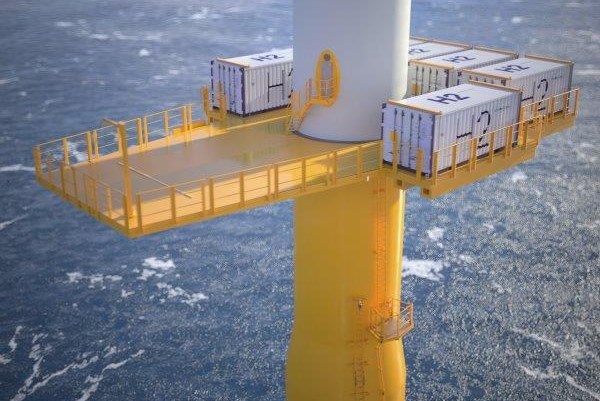Offshore wind-to-hydrogen infrastructure development incorporates Strohm TCP, Siemens Gamesa electrolyzers
Concept for decentralized green hydrogen generation replaces power cables with subsea thermoplastic pipes to transport energy generation from turbine to shore.

Photo Credit: Siemens Gamesa Renewable Energy (SGRE)
Strohm (previously Airborne Oil & Gas, IJmuiden, Netherlands), the manufacturer of fully bonded, thermoplastic composite pipes (TCP), has signed a memorandum of understanding (MOU) with offshore wind leader Siemens Gamesa Renewable Energy (SGRE, Zamudio, Spain).
The collaboration will focus on developing hydrogen transfer solutions that improve the decentralized green hydrogen concept, through which green hydrogen is generated in each wind turbine generator and transported to shore by a subsea pipe infrastructure (learn more about composite developments in this area, “Composites protect subsea cables for offshore wind power”), replacing power cable infrastructure. Under this collaboration, SGRE has a technical advisory role.
Strohm’s TCP product, particularly suited for carrying hydrogen offshore and subsea, is produced at its plant in the Netherlands. According to the company, the corrosion-resistant technology does not fatigue or suffer from issues associated with using steel pipe for hydrogen, such as embrittlement. Manufactured in long, spoolable lengths and flexible in nature, the pipe can be pulled directly into the wind turbine generator, quickly and cost-effectively building an offshore wind farm infrastructure. TCP does not require any maintenance and is suitable for more than 30 years in operation, reportedly lowering the levelized cost of electricity (LCOE) to a minimum.
“This is an exciting collaboration, working with Siemens Gamesa to understand how TCP can be the missing link in an offshore wind farm, generating green hydrogen,” says Martin van Onna, chief commercial officer at Strohm. “Our proven track record with TCP offshore is a prerequisite to be considered a solution in future green hydrogen.”
Similarly, SGRE reports it has already taken significant steps in shaping the wind industry and developing the basis for a decentralized offshore that fully integrates an electrolyzer into an offshore wind turbine, with benefits such as CAPEX reduction, increase of system efficiency and increase of wind farm uptime.
“At Siemens Gamesa, we believe in the potential of green hydrogen and have been working on the decentralized concept for some years,” concludes Finn Daugaard Madsen, innovation manager – Power to X at Siemens Gamesa. “Strohm has supported us through several case studies, identifying the solutions that can be readily used which complement our own systems. This partnership will assist us to innovate together in an open format, accelerating the availability of green hydrogen.”
Related Content
-
Infinite Composites: Type V tanks for space, hydrogen, automotive and more
After a decade of proving its linerless, weight-saving composite tanks with NASA and more than 30 aerospace companies, this CryoSphere pioneer is scaling for growth in commercial space and sustainable transportation on Earth.
-
Sulapac introduces Sulapac Flow 1.7 to replace PLA, ABS and PP in FDM, FGF
Available as filament and granules for extrusion, new wood composite matches properties yet is compostable, eliminates microplastics and reduces carbon footprint.
-
Plant tour: Albany Engineered Composites, Rochester, N.H., U.S.
Efficient, high-quality, well-controlled composites manufacturing at volume is the mantra for this 3D weaving specialist.
















